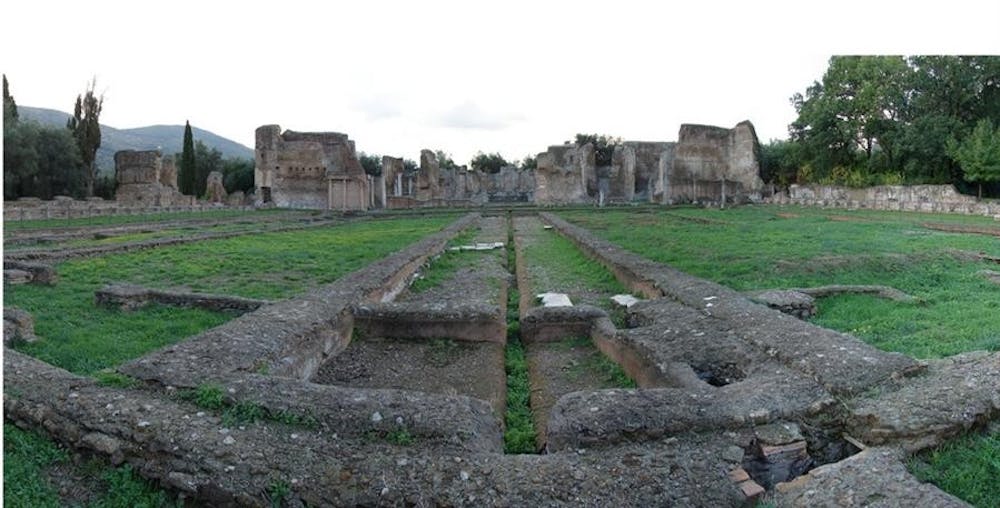Second-century Rome has gone virtual.
An ancient Roman site called Hadrian’s Villa has been recreated as a computer simulation by IU archaeo informaticist Bernie Frischer and is an interactive online world that will soon be available for public use.
Digital Hadrian’s Villa Project is a 3-D model that includes 30 buildings across 250 acres of land. It will come to life in its public unveiling Nov. 22 in Washington, D.C.
“Hadrian’s Villa” refers to a small town where Roman emperor Hadrian reigned from 117 to 138 A.D. It was located near Tivoli, about 20 miles east of Rome, and was home to classic architecture, gardens and sculpture revered in ancient Roman studies.
“This project offers a test bed for experiments in Roman cultural geography, but just as important is the opportunity for virtual world projects like this to become the new textbooks for evidence-based learning,” Frischer said. “What you are experiencing is an immersive learning environment created through the integration and deployment of commercial products, custom software and the knowledge offered by some of the world’s leading experts on Roman history and culture.”
The project was a collaboration between the Institute for Computing and Digital Intermedia Arts at Ball State University and Frischer’s Virtual World Heritage Laboratory at IU School of Informatics.
The finished product will be available as a 3-D multi-user environment online in the next 12 to 18 months.
Visitors can select from a range of avatars that can walk through gardens, temples, bedrooms and libraries. Avatars are sorted based on class, gender and ethnicity, and users can play as characters who are courtiers, soldiers and slaves, among other occupations.
“This avatar system was based on scholarly studies of the circulation and flow throughout the villa,” Frischer said. “The goal was to make everything evidence-based, from the avatars’ costumes to their gestures.”
The academic research behind the digital world comes from collaboration between dozens of academic institutions, museums and the Archaeological Superintendency for Lazio, a unit of the Italian Ministry of Culture, according to the release.
The virtual side was sculpted by the Ball State team at Digital Intermedia Arts, which used the cross platform game engine, Unity, to portray the villa.
“The simulation shows how the site looked during the reign of Hadrian,” Frischer said. “It can be freely explored and used to support teaching and research.”
More than 800 unpublished survey drawings were used to help put it together. The finished product is eerily accurate, Frischer said.
But he said it’s only made him want more.
“It is not only emotionally exciting and satisfying to be able to walk around the sites I have studied, but it also means that my imagination and curiosity have been stimulated to raise new questions or have new insights that never could have occurred to me if I had been limited to just reading the scholarship about the sites,” he said.
He said a related website documents the state of the site today and gives the scholarly background needed to understand the digital simulation.
“The website makes it possible to study the state of the ruins today, including many sites on private land or in parts of the archaeological park closed to the public,” he said.
Frischer said building the virtual villa wasn’t inexpensive.
When they started the project, Frischer said it typically cost more than $10,000 just to make a digital 3-D model of a statue.
There are more than 150 statues on the virtual site. At their high price to recreate, Frischer said the sculptures were the biggest challenge.
But advancements in technology have made it more and more affordable over the years. Eventually the virtual re-sculpting of a statue came at no cost.
“By the time we finished the project, new breakthroughs in computer science gave us new software that make it possible to model a statue for free,” he said.
After all the money and work it took, Frischer said he has high hopes for the virtual world.
He said he’d like to see it become the next revolutionary classroom tool.
“We learned that there is no better way to teach kids about the past than to let them travel there virtually and play historic roles constrained by evidence they collect,” he said. “This is the way to make children engage with history and take ownership of the past.”
Follow reporter Ashley Jenkins on Twitter @ashley_morga.
Archaeologists recreate ancient site

Get stories like this in your inbox
Subscribe




